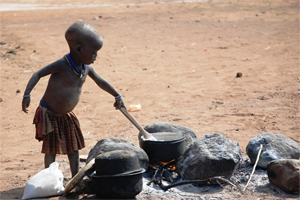
Peter Eceru
Malnutrition is silently stealing Uganda’s future
...it is imperative that we make intentional investments in reducing malnutrition, with a particular focus on vulnerable groups
Peter Eceru
Nutrition
Every year, the world commemorates World Nutrition Day on the 28th day of May to highlight the importance of nutrition.
The National Development Plan(NDP) places a high priority on developing human capital to drive economic growth. It believes that improving education and cognitive achievement will lead to increased productivity, earnings, and gross domestic growth. Uganda Vision 2040 also recognises the importance of investing in nutrition to ensure a high standard of living for its population.
Under NDP III, the Ugandan government acknowledges that achieving a demographic dividend is crucial for economic growth and social development. Demographic dividends are where a country enjoys accelerated growth rates that among others stem from declining mortality rates. By investing in ending malnutrition, not only can Uganda accelerate its economic growth and move closer to middle-income status, but it can also improve the daily lives of its people.
Uganda faces several nutritional challenges, including maternal iodine deficiency, low birth weight, stunting, and anemia. These issues are so widespread in Uganda that the country is wasting its greatest resource: the potential of its children. Ending malnutrition is essential for maximizing the potential of Uganda’s children, as mental capacity, intellectual development, and school performance all rely on good nutrition.
Despite being known as the food basket of East Africa and having abundant arable land, Uganda still struggles with nutrition insecurity. The country consistently grapples with multiple forms of malnutrition. According to the Uganda Demographic and Health Surveys 2022, 24.4 percent of children under five years old are stunted, over 3.2 percent are wasted, 9.7 percent are underweight, and 3.4 percent are overweight.
Additionally, more than 53 percent of women of reproductive age in Uganda suffer from anemia. This situation has serious implications for the quality of human capital, education outcomes, and the healthcare costs for women, infants, and children.
According to the World Health Organisation, malnutrition remains a major global and national health concern. It impacts cognitive development, physical work capacity, and school performance, leading to reduced productivity, socioeconomic growth, and development. Among school-going children, malnutrition can negatively affect cognitive and motor development, resulting in decreased learning capacity and poor school attendance. Moreover, it weakens the immune system, making children more susceptible to infections. This is particularly evident in Uganda, where the population relies heavily on staple foods, resulting in a high prevalence of stunted children in the southwest region, which is the country’s main food producer. It is important to note that malnourished children have a higher mortality and morbidity rate, as they are prone to respiratory infections and diarrhea.
Women’s access to nutritious food is disproportionately affected by national and transnational crises. For instance, the crises in Karamoja and refugee hosting districts push millions of mothers and children into hunger and severe malnutrition. Expectant mothers face even greater challenges, as poor diets lacking key nutrients can lead to complications like anemia, pre-eclampsia, hemorrhage, and death. Hemorrhage alone accounts for 41 percent of maternal deaths in Uganda. Furthermore, poor nutrition during breastfeeding makes it difficult for mothers to replenish their nutrient stores and meet the additional dietary needs of breastfeeding.
Pregnant adolescents also face a higher risk of poor pregnancy outcomes compared to adult women. These include fetal complications such as prematurity, low birth weight, perinatal mortality, congenital defects, hypertensive disorders, abortion, urinary infections, and premature rupture of fetal membranes. Pregnant adolescent girls are more likely to suffer from malnutrition and its associated medical challenges than older women.
In order to address the current situation, it is imperative that we make intentional investments in reducing malnutrition, with a particular focus on vulnerable groups. Given the high rate of teenage pregnancy in our country, which currently stands at 24 percent, it is crucial that we prioritize support for teenage mothers. Adolescent pregnancy is known to have negative effects on fetal growth and development, thereby increasing the risk of childhood wasting and underweight. These vulnerable groups consist of adolescent girls, women, and children.
To effectively combat malnutrition, it is essential for the government to implement policies and enforce mandatory legal measures aimed at expanding the large-scale fortification of commonly consumed foods, such as flour, cooking oil, and salt.
Mr Peter Eceru works at Action Against Hunger.



